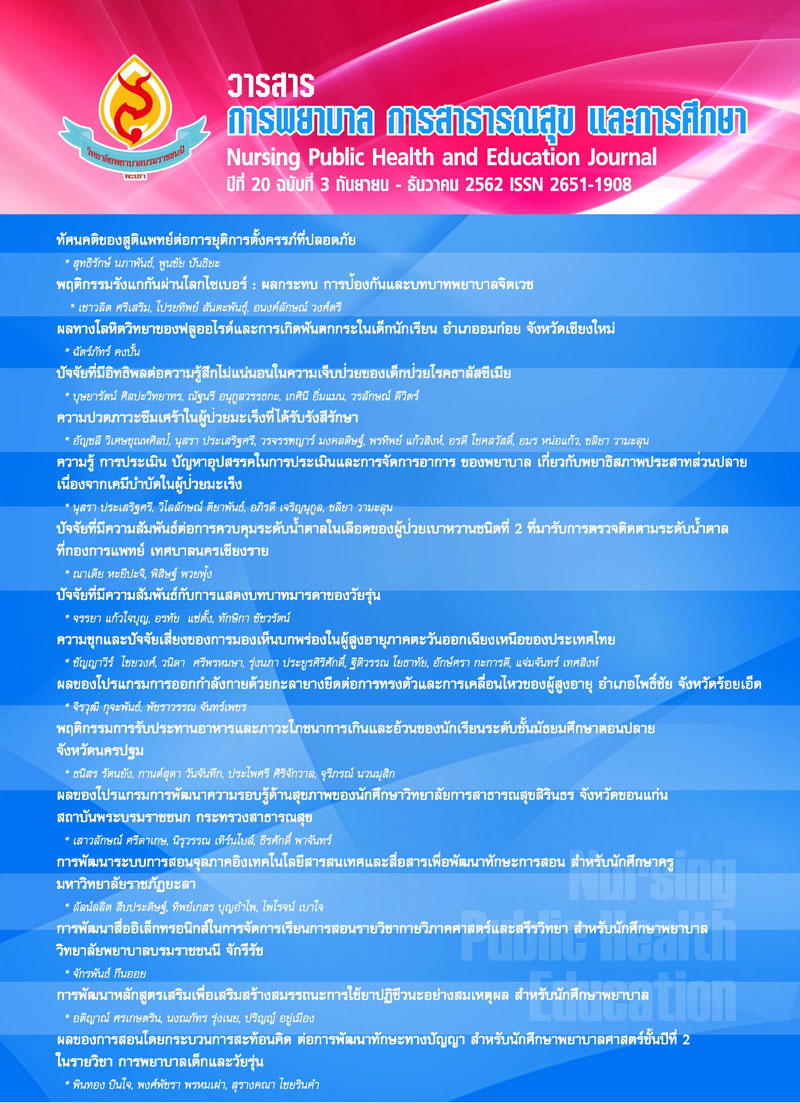ปัจจัยที่มีอิทธิพลต่อความรู้สึกไม่แน่นอนในความเจ็บป่วย ของเด็กป่วยโรคธาลัสซีเมีย
คำสำคัญ:
การสนับสนุนทางสังคม, ความรู้เกี่ยวกับความเจ็บป่วย, ความรู้สึกไม่แน่นอนในความเจ็บป่วย เด็กป่วยโรคธาลัสซีเมีย, social support, illness-related knowledge, illness-related uncertainty, children with thalassemiaบทคัดย่อ
การวิจัยครั้งนี้เป็นการวิจัยเชิงพรรณนาแบบหาความสัมพันธ์เชิงทำนายเพื่อศึกษาปัจจัยที่มีอิทธิพลต่อความรู้สึกไม่แน่นอนในความเจ็บป่วยของเด็กป่วยโรคธาลัสซีเมีย กลุ่มตัวอย่าง คือ เด็กป่วยโรคธาลัสซีเมีย อายุ 8-15 ปี ที่เข้ารับการรักษาด้วยการให้เลือดในหอผู้ป่วยกุมารเวชกรรมโรงพยาบาลพะเยา โรงพยาบาลลำปาง และโรงพยาบาลเชียงรายประชานุเคราะห์จำนวน 88 ราย เก็บข้อมูลระหว่างเดือนมกราคม ถึง มิถุนายน 2561 เครื่องมือที่ใช้ในการวิจัย ได้แก่ แบบสอบถามข้อมูลทั่วไปของเด็กป่วยโรคธาลัสซีเมีย แบบสอบถามความรู้สึกไม่แน่นอนในความเจ็บป่วยของเด็กป่วยโรคเรื้อรังแบบสอบถามกรอบสิ่งกระตุ้นของเด็กป่วยโรคธาลัสซีเมียแบบสอบถามการสนับสนุนทางสังคมของเด็กป่วยโรคธาลัสซีเมียและแบบสอบถามความรู้เกี่ยวกับความเจ็บป่วยของเด็กป่วยโรคธาลัสซีเมีย แบบสอบถามเหล่านี้มีค่าดัชนีความตรงตามเนื้อหาระหว่าง 0.88-0.94 และมีค่าสัมประสิทธิ์ความเชื่อมั่นระหว่าง 0.83-0.95 วิเคราะห์ข้อมูล โดยหาค่าความถี่ ร้อยละ ค่าเฉลี่ย ส่วนเบี่ยงเบนมาตรฐาน ทดสอบความสัมพันธ์ของตัวแปรด้วยสถิติสัมประสิทธิ์สหสัมพันธ์ของเพียรสัน และวิเคราะห์การทำนายด้วยสถิติถดถอยแบบพหุ ผลการวิจัย พบว่าความรู้สึกไม่แน่นอนในความเจ็บป่วยของเด็กป่วยโรคธาลัสซีเมียอยู่ในระดับปานกลาง ( = 70.60, SD = 5.64) กรอบสิ่งกระตุ้น การสนับสนุนทางสังคม และความรู้เกี่ยวกับความเจ็บป่วย มีอิทธิพลต่อความรู้สึกไม่แน่นอนในความเจ็บป่วยของเด็กป่วยโรคธาลัสซีเมีย (β= 0.486, p < .05, β = - 0.275, p < .05 และ β= - 0.335, p < .05 ตามลำดับ) โดยสามารถร่วมทำนาย ความรู้สึกไม่แน่นอนในความเจ็บป่วยของเด็กป่วยโรคธาลัสซีเมีย อย่างมีนัยสำคัญทางสถิติ ที่ระดับ .05 และสามารถอธิบายการผันแปรของความรู้สึกไม่แน่นอนในความเจ็บป่วยของเด็กป่วยโรคธาลัสซีเมียได้ร้อยละ 47.60 (adjusted R2 = .476)
Factors Influencing Illness-Related Uncertainty in Children with Thalassemia
This research employed a predictive correlational research design with the objective of studying the factors influencing illness-related uncertainty in children with thalassemia. The study sample included 88 children with thalassemia aged between 8 to 15 years who were treated with blood transfusions in the pediatric wards of Phayao Hospital, Lampang Hospital and Chiang Rai Prachanukhroh Hospital, and the data were collected from January to June 2018. The research instruments consisted of the personal data of children with thalassemia, the children’s uncertainty in illness scale, the stimuli frame of children with thalassemia scale, the social support of children with thalassemia scale, and the illness-related knowledge of children with thalassemia scale. The content validity index and reliability coefficients of these scales were between 0.81-0.86 and 0.83-0.95, respectively. The data were analyzed using frequency, percentage, mean, standard deviation, Pearson product-moment correlation, and multiple regression analysis. The results showed that the children with thalassemia had illness-related uncertainty at a moderate level ( = 70.60, SD = 5.64). The stimuli frame, social support, and illness-related knowledge influenced the illness-related uncertainty (β= 0.486, p < .05, β = - 0.275, p < .05 and β= - 0.335, p < .05). Altogether, these three factors could predict the illness-related uncertainty of children with thalassemia with statistical significance at the .05 level and were able to explain the variance of illness-related uncertainty at 47.60% (adjusted R2 = .476).
เอกสารอ้างอิง
บัณฑิตา นฤมาณเดชะ. (2552) ความรู้เกี่ยวกับความเจ็บป่วย การสนับสนุนทางสังคม และความรู้สึกไม่แน่นอนในความเจ็บป่วยของเด็กวัยรุ่นเอส แอล อี. พยาบาล
สาร. 36(1), 66-77.
บุษบา ทาธง. (2555). ปัจจัยที่มีอิทธิพลต่อความรู้สึกไม่แน่นอนในความเจ็บป่วยของเด็กป่วยโรคมะเร็งที่ได้รับเคมีบำบัด. พยาบาลสาร. 39(1), 77-90.
บุษยารัตน์ ศิลปวิทยาทร. (2558). ความรู้สึกไม่แน่นอนในความเจ็บป่วยและวิธีการเผชิญความเครียดของเด็กป่วยโรคธาลัสซีเมีย. วารสารสภาการพยาบาล. 30(3),
67-79.
ปกรณ์ พลาหาญ และระวีวรรณ พันธ์พานิช. (2536). คู่มือตัดเกรด. กรุงเทพฯ: สุวีริยาสานส์.
ศรีพรรณ กันธวัง. (2550). แบบประเมินความรู้สึกไม่แน่นอนในความเจ็บป่วยของเด็กป่วยโรคเรื้อรัง. เอกสารไม่ได้ตีพิมพ์. เชียงใหม่: คณะพยาบาลศาสตร์ มหาวิทยาลัย
เชียงใหม่.
ศูนย์ข้อมูลและสถิติโรงพยาบาลเชียงรายประชานุเคราะห์. (2560). รายงานสถิติผู้ป่วยเด็กโรคธาลัสซีเมีย. เชียงราย: ศูนย์คอมพิวเตอร์ โรงพยาบาลเชียงราย
ประชานุเคราะห์.
ศูนย์ข้อมูลและสถิติโรงพยาบาลลำปาง. (2560). รายงานสถิติผู้ป่วยเด็กโรคธาลัสซีเมีย. ลำปาง: ศูนย์คอมพิวเตอร์ โรงพยาบาลลำปาง.
ศูนย์คอมพิวเตอร์ โรงพยาบาลพะเยา. (2559). รายงานสถิติผู้ป่วยเด็กโรคธาลัสซีเมีย. พะเยา: ศูนย์คอมพิวเตอร์ โรงพยาบาลพะเยา.
Behdani, F., Badiee, Z., Hebrani, P., Moharreri, F., Badiee, A. H., Hajivosugh, N., et al. (2015). Psychological aspects in children and
adolescents with major thalassemia: a case-control study. Iran J Pediatric, 25(3), 1-8.
Burns, N., & Grove, S. K. (2005). The practice of nursing research: Conduct. Critique, & utilization. (5th ed.). St. Louis: Elsevier
Saunders.
Caocci, G., Efficace, F., Ciotti, F., Roncarolo, M. G., Vacca, A., Piras, E., et al. (2012, December 12). Health related quality of life in
Middle Eastern children with beta-thalassemia. Retrieved June 1, 2017, from https://bmchematol.biomedcentral.com/article /
10.1186/1471-2326-12-6.
Cobb, S. (1976). Social support as a moderator of life stress. Psychosomatic Medicine. 38(5), 300-314.
Mishel, M. H. (1983). Adjusting the fit: Development of uncertainty scales for specific populations. Western Journal of Nursing
Research, 5, 355-370.
Mishel, M. H. (1988). Uncertainty in illness. Image Journal Nursing Schorlarship, 20(4),225-232.
Moafi, A., Valian, S., Nikyar, Z. (2010). Prevalence of minor beta thalassemia based on RBC indice. Int J HematolOncholStem Cell.
Res, 23-27.
Mullins, L. L., & Hartman, V. L. (1995). Children’s uncertainty in illness scale. Unpublished manuscript.
Neville, K. (1998). The relationship among uncertainty, social support, and psychological distress in adolescents recently diagnosed
with cancer. Journal of Pediatric Oncology Nursing, 15, 37-46.
National Heart, Lung, and Blood Institute. (2012, November 11). What causes thalassemia’s?. Retrieved June 1, 2017, from
https://www.nhlbi.nih.gov/health-topics/thalassemia.
Piaget, J. (1973). Piaget's theory. Handbook of child psychology. (4th ed.). New York: Wiley.
Schaefer, C., Coyne, J. C., & Lazarus, R. S. (1981). The health-related function of social support. Journal of Behavioral Medicine, 4,
381-405.
Sharma, D. C., Arya., Kishor, P., Woike, P., Bindal, J. (2017). Overview on thalassemias: a review article. Medico Research Chronicles,
4(3), 325-337.
Soliman, Ashraf, T., Kalra, Sanjay, D. S., Vincenzo. (2014). Anemia and growth. Indian Journal of Endocrinology and Metabolism, 18
(1), 1-5.



